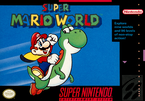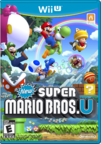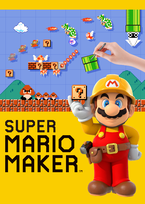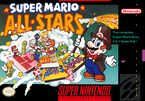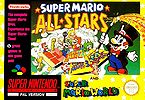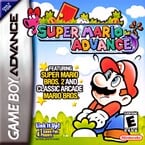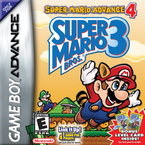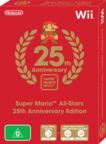Super Mario Bros. (series)
From the Super Mario Wiki, the Mario encyclopedia
Jump to navigationJump to search
Template:Articleabout Template:Series-infobox The Super Mario Bros. series are a part of the Super Mario series. It started in 1985 with the creation of Super Mario Bros. on the Famicom and subsequently the Nintendo Entertainment System.
Main games
It has been requested that this article be rewritten and expanded to include more information.
| Title, original release and system | Synopsis and Ratings |
|---|---|
| Super Mario Bros.
|
Super Mario Bros. is the first installment in the Super Mario series. It was first released for the Famicom and the NES in 1985. This game set the standard for the later games, and it was eventually re-released for many newer systems, including the Game Boy Advance and the Virtual Console for the Wii. This game marks the first appearance for many new protagonists, species, and villains. These characters include Bowser, Princess Peach (then known as Princess Toadstool), Toad and the Mushroom Retainers, Goombas, Koopa Troopas, and many more. |
| Template:Releasedate NES | (Ratings unavailable) |
| Super Mario Bros.: The Lost Levels
|
A year after the release of Super Mario Bros., Nintendo released Super Mario Bros.: The Lost Levels. It was released for the Famicom Disk System. It uses a slightly altered version of Super Mario Bros.'s engine, with different levels and new features including altered graphics and new enemy behavior. This game is known in Japan as Super Mario Bros. 2; Nintendo of America originally deemed this game too challenging and too much like the original to sell well in western countries. However, the game made its appearance in western countries as part of Super Mario All-Stars, and recently, this game was released for the Virtual Console on the Wii. |
| Template:Releasedate Famicom | (Ratings unavailable) |
| Super Mario Bros. 2
|
Super Mario Bros. 2 is the third game in the Super Mario series. It was released in 1988 for the Famicom and the NES. New species first appear in this game, including Albatoss and Shy Guys, and it introduces Wart and Birdo. Super Mario Bros. 2 is also the first game to feature four distinctly playable characters (Mario, Luigi, Toad, and Princess Peach). Super Mario Bros. 2 was based on the Japanese game Yume Kōjō: Doki Doki Panic. In Japan, this game is commonly called Super Mario USA. |
| Template:Releasedate NES | (Ratings unavailable) |
| Super Mario Bros. 3
|
Super Mario Bros. 3 is the fourth Super Mario game. It was released for the Famicom and the NES. Many new species appear, including now-staples like Boo and Spike. Boom Boom, Dry Bones, and the Koopalings also first appear here. New power-ups also appear such as the Super Leaf, the Hammer Suit and the Frog Suit. It has been considered as one of the greatest games of all time. Its complexity and challenging levels made it a huge success. In addition to new power ups, it featured new moves, items, and enemies. It also features special non-level parts of each world, including Toad Houses where lives are earned and Spade Panels, as well as some secret parts, such as the White Toad House and the Treasure Ship. |
| Template:Releasedate NES | (Ratings unavailable) |
| Super Mario World
|
Super Mario World was released in 1990 for the Super Famicom. It was also re-released as the second installment in the Super Mario Advance series. In this game Mario and Peach go on a trip to Dinosaur Land but things go awry when Bowser kidnaps Peach. This game was notable for introducing Yoshi and the species. It is the fifth installment in the Super Mario series. |
| Template:Releasedate SNES | (Ratings unavailable) |
| New Super Mario Bros.
|
New Super Mario Bros. is the eighth installment in the Super Mario series. It starts out when Bowser Jr. kidnaps Peach during a strange accident. Luigi is playable in this game, too. Luigi was not playable since Super Mario World. This is the first game since Super Mario World (1990) that features the classic 2D play-style of the Super Mario Bros. games. The game features a solo story mode with Mario or Luigi, a two-player wireless game Mario vs. Luigi, as well as a mini-game mode for up to four players. It was released in 2006 for the Nintendo DS. It spiraled a sequel, New Super Mario Bros. Wii, though that game is not considered to be a direct sequel to the DS game. |
| Template:Releasedate Nintendo DS | IGN - 9.5: Incredible • Gamespot - 9.0: Superb |
| New Super Mario Bros. Wii
|
New Super Mario Bros. Wii is the tenth installment in the Super Mario series and the second for the Wii. It is an indirect follow-up to New Super Mario Bros.. In this game, Yoshis are rideable and the Koopalings return. In addition to the single-player experience, the game also features a multiplayer mode for up to four players simultaneously. This is the first time simultaneous multiplayer is possible in a Super Mario game. Two new playable characters appear, Yellow Toad and Blue Toad. New power-ups also appear including the Propeller Suit and the Penguin Suit. |
| Template:Releasedate Wii | IGN - 8.9: Great • Gamespot - 8.5: Great |
| New Super Mario Bros. 2
|
New Super Mario Bros. 2 is another side-scroller in the series released in 2012 for the Nintendo 3DS. It's the third game in the New Super Mario Bros. line and a direct sequel to New Super Mario Bros.. The game features an extremely large amount of coins, which are one of the game's main elements. Raccoon Mario makes a return. A new power-up called the Gold Flower appears and turns Mario into Gold Mario. |
| Template:Releasedate Nintendo 3DS | IGN - 8.5: Great • Gamespot - 7.0: Good |
| New Super Mario Bros. U
|
New Super Mario Bros. U is a side-scroller for the Wii U. The game seems to borrow some elements from Super Mario World such as Baby Yoshis, Sumo Bros., Bony Beetles, etc. and minor references like diagonal pipes making a return. The game plays very similar to New Super Mario Bros. Wii with its four-player mode, however a player with a Wii U GamePad can create platforms in what Nintendo refers to as "Boost Mode". It is the first Super Mario game (and Mario game overall) to be released in high-definition. The game also introduces a new form, Flying Squirrel Mario. |
| Template:Releasedate Wii U | IGN - 9.1: Amazing • Gamespot - 8.5: Great |
| Super Mario Maker
|
Super Mario Maker is a Super Mario course builder for the Wii U released in 2015. It allows players to create and edit levels based on several Super Mario games, such as Super Mario Bros., Super Mario World, Super Mario Bros. 3, and New Super Mario Bros. U. It was released for the 30th anniversary of the release of Super Mario Bros. |
| Template:Releasedate Wii U |
Ports, remakes, and downloadable content
| Title, original release and system | Synopsis and Ratings |
|---|---|
| Super Mario Bros. (Game & Watch)
|
In 1987, a simplified take on the Super Mario Bros. formula was released for the Game & Watch. It is a sidescroller where Mario had to move over several platforms, avoiding Lakitus and Bullet Bills. |
| Template:Releasedate Game & Watch | (Ratings unavailable) |
| Super Mario All-Stars
|
Super Mario All-Stars also known as Super Mario Collection in Japan was released in 1993 also for the Super Nintendo Entertainment System. It is a remake of the first four Super Mario series games. Super Mario Bros., Super Mario Bros. 2 Super Mario Bros. 3, and Super Mario Bros.: The Lost Levels. This game updated the four games' graphics and sound to enhance them. However, it is not technically considered an installment because it is just a simple remake. |
| Template:Releasedate SNES | (Ratings unavailable) |
| Super Mario All-Stars + Super Mario World
|
Super Mario All-Stars + Super Mario World is an America/Europe-only remake of Super Mario All-Stars that also includes Super Mario World for the Super Nintendo Entertainment System. It is the second remake of the series. |
| Template:Releasedate SNES | (Ratings unavailable) |
| Super Mario Bros. Deluxe
|
Super Mario Bros. Deluxe is a Game Boy Color remake which includes the first two Super Mario games ever released: Super Mario Bros. and Super Mario Bros.: The Lost Levels (that last under the name of Super Mario Bros.: For Super Players). Besides those games, it also featured many other collectibles, including images that could be printed with the Game Boy Printer, Cable Link interface multi-player, records sharing by infrared connection, a calendar, a fortune teller, etc. Unlike other remakes, it wasn't developed by Nintendo EAD, but by Nintendo R&D2. |
| Template:Releasedate Game Boy Color | IGN - 10: Masterful • Gamespot - 9.9: Superb |
| Super Mario Advance
|
Super Mario Advance is a remake of Super Mario Bros. 2 made for the handheld game system, the Game Boy Advance, and released in 2001. Like the Super Mario All-Stars port, Super Mario Advance had updated graphics. |
| Template:Releasedate Game Boy Advance | IGN - 8.0: Great • Gamespot - 8.2: Great |
| Super Mario World: Super Mario Advance 2
|
Super Mario World: Super Mario Advance 2 is a remake of Super Mario World made for the Game Boy Advance. It was the second title in the Super Mario Advance series and was released in 2002. There are various differences between the original Super Mario World and Super Mario Advance 2. The game was a gigantic hit for Nintendo and the Game Boy Advance, selling 3,290,000 copies in the United States and 5,460,000 copies worldwide. Additionally, Luigi's sprite has been changed and made taller than Mario to match his normal appearance, and the Mario Bros. classic game has been included in the game (like the other Mario Advance games), with multiplayer playable. |
| Template:Releasedate Game Boy Advance | IGN - 9.3: Amazing • Gamespot - 9.4 |
| Super Mario Advance 4: Super Mario Bros. 3
|
In 2003, the fourth entry in the Super Mario Advance series, Super Mario Advance 4: Super Mario Bros. 3, was released for the Game Boy Advance. It boasted similar graphics and sound to the Super Mario All-Stars version, and made use of the e-Reader. A few e-cards came included with new copies of the game, while two sets (referred to as "series") of cards, were released and sold alongside the game. By scanning special cards into the e-Reader, players were able to upload items, videos, and most importantly, new levels into the game. One notable item was the Cape Feather from Super Mario World, which allowed Mario to transform into Cape Mario. There were also two Switch cards that the player could activate (and deactivate) the effects of by scanning them; the Orange Switch and the Blue Green Switch. Scanning these switches triggered small functions in the game. The e-Reader feature is still available in the European version, but it is disabled by default and unable to access. |
| Template:Releasedate Game Boy Advance | IGN - 9.5: Amazing • Gamespot - 8.9: Great |
| Classic NES Series: Super Mario Bros.
|
The original NES version of Super Mario Bros. was released for the Game Boy Advance as part of the Classic NES series of games in commemoration for the 20th anniversary of the release of the original Famicom and NES. It is a port, and doesn't feature any new additions, and all of the bugs were left in the game and only the graphics were down-scaled to fit the GBA screen resolution. |
| Template:Releasedate Game Boy Advance | (Ratings unavailable) |
| Famicom Mini: Super Mario Bros. 2
|
In Japan, the Classic NES Series were known as Famicom Mini. The original Super Mario Bros. 2 (known in western regions as Super Mario Bros.: The Lost Levels) was released only in Japan. Much like Super Mario Bros., it didn't feature any new additions, the bugs were left untouched, and the graphics were down-scaled. |
| Template:Releasedate Game Boy Advance | (Ratings unavailable) |
| Super Mario All-Stars Limited Edition
|
Released for the Wii in 2010, Super Mario All-Stars Limited Edition celebrates the 25th anniversary of Mario featuring the same games as mentioned in the All-Stars section. It is a port of the original game Super Mario All-Stars. |
| Template:Releasedate Wii | IGN - 7.0: Good |
| New Super Luigi U
|
New Super Luigi U is a game released to celebrate the Year of Luigi. It retains many graphics and features, such as the story and world map, have been retained from New Super Mario Bros. U, as it has also been released as a DLC title for said game. However all of the levels have been changed, and this time, Mario is absent, making Luigi the main character. Nabbit has been made a playable character, taking Mario's place. The packaged version was available at retail until the end of the Year of Luigi (2013). |
| Template:Releasedate Wii U | IGN - 7.3: Good |
| New Super Mario Bros. U + New Super Luigi U File:Box NA - New Super Mario Bros. U + New Super Luigi U.png |
A compilation of both New Super Mario Bros. U and New Super Luigi U on the same disc, released exclusively with the Mario & Luigi Deluxe Wii U set (known as the Premium Pack in Europe). New Super Mario Bros. U + New Super Luigi U includes notable changes to the originals, including a new title screen and over 200 videos included as bonus content. |
| Template:Releasedate Wii U |
